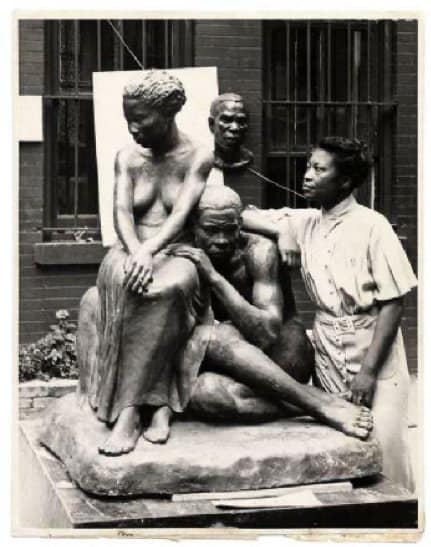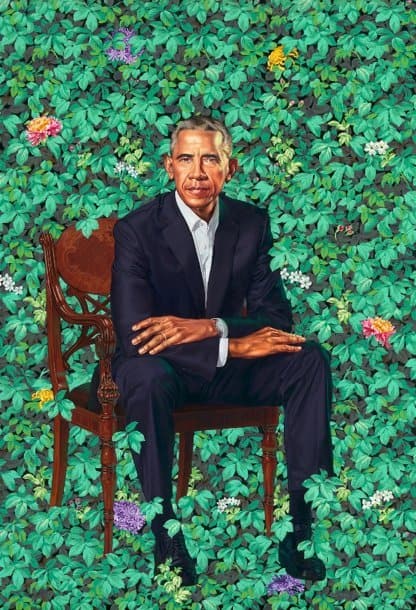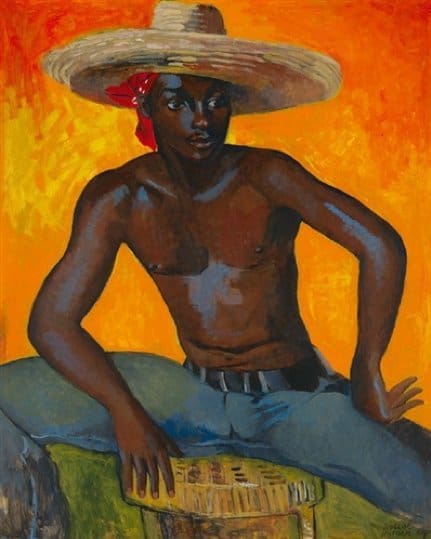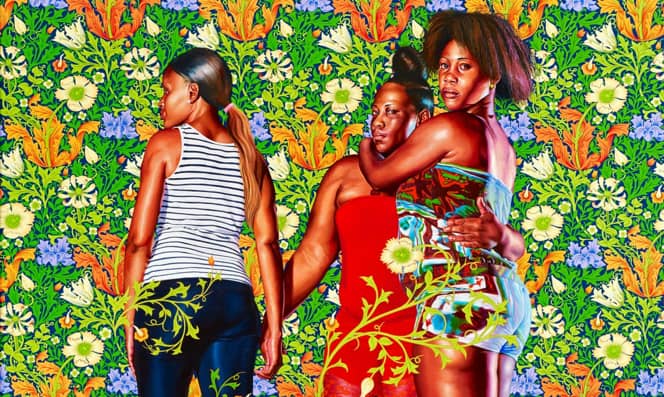Art and the Lack of Black People in History
Fine art has ever been a part of man existence. Specially black art.
Since the beginning of time, the peoples of the world have used art as ways of communication, expression, and even a ways to document history, as can be seen in the caves on ancient Egyptian kings and queens.
The special thing about visual fine art is it leaves the world up to the artist's interpretation.
In a world where historically, blackness people haven't been allowed to be the most vocal, some found solace in art.
And every bit a young Black woman, I'one thousand then glad they did.
Black Art Mirrors Black History
Nosotros know before slavery, nations in Africa were full of fine art, sculptures, statues, tribal cloths, etc.
And so much of that civilization was lost in the middle passage, and on the selling block when slavers purposely separated people from their tribes.
This was an intentional program to prevent whatsoever uprising or pride a slave may have in themself. Withal, talent is something that cannot be stripped from a person.
Some of the primeval African American visual artists came during slavery.
Slaves by in big did non have admission to formal education, and particularly not art training, even for the few that did learn to read and write.
If they were lucky enough to be taught a special skill it was usually to entertain slave owners. Though few and far between, they did exist.
African American artists had a difficult time breaking into mainstream civilization.

Much like Blackness culture, Black art is influenced by both traditional African civilization and Western culture forced upon them.
Merely, Black artists have been creating thought-provoking art for centuries.
Not at the same volume every bit mainstream artists because of things similar slavery, and systemic racism preventing Blacks from education, and jobs that would beget them to exist able to buy the supplies needed to be an artist.
One of the get-go African American artists to receive recognition in America was Joshua Johnson (too spelled Johnston).
He was from Baltimore, Maryland, and gained recognition betwixt 1790 and 1825.
Known for his portraits, Johnsons was built-in from a slave mother an aristocrat begetter and given his freedom by the age of 21. Like many other Black artists who emerged at a fourth dimension when blacks were not allowed to be educated, Johnston was a self-taught painter.
Most of his work focused on children of the aristocratic families of the day and some Black subjects, one of which was Daniel Coker, a founder of the African Methodist Episcopal Church building.
Though as early as the 19th century nosotros run into the outset Blackness artists receiving national and sometimes international praise for their work, information technology is not until later that we see black artists emerge into mainstream culture.
Slavery played a big part in how little Black fine art was created and perceived, only abolitionists were instrumental in helping the first black artists in America get the piffling notoriety that they did get.
Though spread around and few and far betwixt, African American visual artists did exist in the 1800s, and not but as painters.
Joshua Johnston was the first to received national recognition but the 19th century saw several African American artists sally like Robert Southward. Duncanson, Edward Mitchell Bannister, and Henry Ossawa Turner were all notable artists of the menstruum.
Some artists like Turner had formal training from the Philadelphia Academy of The Fine Arts, and some were self-taught.
Those who were self-taught non merely speak to the beauty of the creative'southward mind; having the vision, but as well the resourcefulness that African Americans are known for.
Even so, it has continued to exist difficult to gain recognition and praise from the dominant culture.
Black Art Afterward Slavery

Post-slavery, the next notable wave of black artistry was ushered in with the Harlem Renaissance.
It was a beautiful time for blackness artists and the most celebrated historical awakening for Black Americans thus far.
We had more access to teaching and new experiences which is why nosotros saw and then many artists come out of this menstruation.
When we recollect about the Harlem Renaissance we often retrieve almost the writers and singers, Langston Hughes comes to mind first, simply the visual artists were simply as present.
The roaring 20s every bit they are normally referred to, was a time of fun and enlightenment for Blackness people in America.
After war, abolitionism, and struggle, the post-slavery South was no identify for Black Americans. They faced new dangers like Jim Crow laws, the Klan, and sharecropping which meant a life of debt.
Ushered in by what became known as the Great Migration, Midwestern and Northern cities saw an increase in Black residents moving North for amend opportunities for jobs and life exterior of the racism of the South.
New York City has always been it's own melting pot inside the larger cauldron that is the United states of america, and the new gratuitous blacks were no different.
For the first time, we were seeing areas with high concentrations of Black people who were educated, working, and thriving in predominately black communities.
Dissimilar the artists before them, in the Harlem Renaissance, Black artists began painting Black families and faces.
Briefly, I want to touch on how the economic shift of free African Americans shifted the art world.
Staring in the Harlem Renaissance, African Americans finally had their ain homes and money to spend.
Giving Black artists not only a target marketplace but a network of other artists to work with.
Whereas before, we meet the artists of slavery being mulatto, passing for white at times using that to their advantage for mobility, and only painting white faces and landscapes more often than not.
The Harlem Renaissance meant and so much more to the upward mobility of African Americans.
Gone were the days where Blackness artists needed white recognition because with freedom and income they could afford to put on their own shows in their communities.
Although the Corking Low (1929-1939) devastated the country, it besides created opportunities for African American artists.
With assistance from the Works Progress Administration (WPA), Augusta Savage was able to pb the Harlem Community Center and The New Deal's Federal Arts Projects encouraged Black artists to create art for upliftment.
Nevertheless, every bit we forged into the 50s and 60s racial tensions in America once over again began to ascent, taking the focus away from art and creation and pushing information technology to equality and desegregation.
The art created was powered by the idea of Blackness Power and Civil rights.
Charles White and Jeff Donaldson were two Black visual artists who emerged on the scene among the Civil Rights Motility.
Charles White was a Chicago built-in activist and artist knows for his paintings, drawings, lithographs, and murals.
Artists take a responsibility to activism, or at least that's how Charles White Saw information technology, "Art must be an integral part of the struggle," White insisted. "Information technology tin't simply mirror what's taking place. It must marry itself with the forces of liberation."
This quote is powerful and captures the essence of Black Art.
Black Artists for sure make art because we like creating, but our lives near force us to commit our art to the cause.
The Black Ability Era introduced a new era of the black aesthetic. Black skin was in, afros, and expressions of love for black life were all the rage.
So, it is no surprise that in the 80s, came Jean Michael Basquiat who would exist the starting time African American Art superstar.

A punk child who outset piqued people'southward interests as an unknown graffiti creative person, Jean Michael Basquiat had nigh a following most immediately.
He also worked with artists like Andy Warhol.
Basquiat'south use of words, numbers, and his overall style made him stand out.
His contributions to art were instrumental in pushing black art in the 90s.
Basquiat was the first black artist to receive acceptance from mainstream critics, which meant people were finally starting to give much overdue credit to Black artists.
The 80s was the first time in history that Black art exhibitions could exist found at multiple mainstream galleries throughout the U.s.a. and even away. In the 1990s, Blackness Art excelled on mainstream levels.
Lorna Simpson was the commencement black woman to present art at Venice Biennale, allowing the most marginalized of people in the The states, black women, to take center stage as the world looked on.
Success Confronting All Odds
Looking at the development of Blackness art, it's hard to believe it has existed every bit largely equally it did at a time when many black people were not privy to the arts.
Withal, the ones that were, were non widely accepted amid the dominate culture.
Non in life, and about certainly not in the arts.
Co-ordinate to the Smithsonian American Art Museum website, Edward Mitchell Bannister was harshly critiqued by a reviewer who said, "… the negro has an appreciation for fine art while being manifestly unable to produce information technology."
This statement was published in the New York Herald in 1867.
There was a lack of appreciation for Black artists which fits the racial climate of the time. However, fifty-fifty without the acceptance of the masse, they continued to create and exist great artists.
Today more Black artists are emerging than e'er before.
As art mediums proceed to expand past the traditional mediums like painting, sculpture, drawing, more artists are turning to digital media, graphic pattern.

Performance arts are also among styles emerging from new Black Artists.
Some of the pop Blackness Artists of today are Kara Walker who is known for her silhouettes, installation pieces, and films.
Kehinde Wiley is another prominent blackness creative person of today who does by and large portraits of African American Faces.
I of his more famous pieces is his recent portrait of 44th President of the United States, Barack Obama.
Cartoons, Media and The Evolution of Black Art
The history of African Americans in animation is much similar the history of Blacks in this country – not good until more recently.
Much like older movies, older cartoons likewise characteristic caricatures of negative black stereotypes.
Before Black men and women were allowed to act alongside whites, white people would clothes up in blackface.
If you expect at the early animation of Black people, the characters resemble a mix between people dressed in blackface and exaggerated features such as large noses and big pinks lips.
Attached is a link to early on animated black cartoons, including some examples of the aforementioned. Information technology'due south jarring to meet the breathy racism and colorism, much of which all the same exists today.
Amusement powerhouses like Disney and Warner Bros accept both had to pull scenes and movies from their collections.
Equally the Ceremonious Rights Move brought in new expectations about what was acceptable and what was not mainstream media outlets had to get on lath.
Disney removed characters and scenes from movies like Fantasia and Dense.
While Warner Brothers had to remove entire films, such as Coal Blackness and the Sebben Dwarves, along with eleven other permanently shelved films from their entire catalog.
For historical context, hither's a listing of racist cartoons from America'southward past.
Over time, black cartoons proved to exist profitable with the emergence of shows like Fat Albert and The Harlem Globetrotters.
But they would still have the token black friend. Similar Susie Carmichael on Rugrats, Vince on Recess, and the list goes on.
The 90s brought u.s. Bebe's Kids the first Blackness Animated One-act of its type. Voiced by Comedian, Faizon Love, Bebe's Kid's was an instant classic amongst black families.
The early 2000s gave us shows like The PJ'southward and The Proud Family, both fully blackness cartoons. The PJs was special because it was the first black, animated, developed serial.
Aaron McGruder'due south The Boondocks took Cartoon Network by storm with its hilarious satire manner.
The Cleveland Brownish Evidence was another that came as a spin-off of the widely accepted Family Guy. Simply the main character was nevertheless voiced past a white voice histrion up until his recent resignation.
Equality Representation is The Goal

Black art has long been in existence and for a long time it but got as much exposure as the mainstream would give it.
We are entering a time now where Blackness civilisation is rivaling the dominant culture in mainstream gild.
The mix of social media and the desire of younger Blackness people to support and buy black has been a big push.
If that'south not weird enough, we're starting to run into more characters of color on the argent screen, in everything from regular roles to superheroes, villains, and everything in betwixt.
Representation matters, for sure. And we are seeing more black representation and more of the right representation.
Today, with new engineering and more access, at that place are more than Blackness artists than ever. Including myself.
Especially in the graphic pattern field, creating everything from cartoons, logos, video games, music videos, and just about anything the heed can dream.
Black Americans go on to deal with discrimination in all areas, but particularly in the world of art and media.
The primeval cartoons, a clear reflection of society at the time, featured racist art such as characters with overly exaggerated noses and lips.
Product companies even used incorrect grammer for film titles and pushing every stereotype of Blacks that we even so run into.
There are so many different types of fine art within the realm of Black art. From painting to cartoon, murals, and sculptures, Black people take proven to exist amongst some of the most bright artistic minds.
Equally engineering science advances, times change, and nosotros gain more admission, we continue to encounter just how beautifully artistic and creative Black people are.
We've always been colorful and vibrant. Merely for the longest, our wild hair-dos and colors were seen as ghetto, and not expressive or even creative in some cases.
At present magazines are full of traditional Blackness Hairstyles on non-Black women. As Black faces and minds start to occupy more creative spaces, I both look forward to and roll my eyes at how mainstream civilization will use the black aesthetic.
For black artists, the fight to become mainstream notoriety is an uphill battle.
Why Black Art Matters
Why does Black art matter?
The same reason representation matters.
Fine art is another mode of storytelling. Storytelling is a method of preserving history. Black art expresses the feelings of the moment just as well serves equally a history lesson for Blackness children.

Augusta Savage said in Metropolitan Magazine in 1935, "I accept created zip really beautiful, really lasting, but if I can inspire 1 of these youngsters to develop the talent I know they possess, so my monument will exist in their work."
She and then but, and eloquently explained why Black Fine art matters then much.
Just recently we saw networks canceling shows like Cops and Alive PD because not only do they perpetuate constabulary violence, but they likewise push negative stereotypes.
This is why representation is so important.
Representation for Black People past Black creatives is even more than important. No 1 can tell our story amend than u.s.!
For years mainstream media and Hollywood have whitewashed the Black experience to fit the narrative of the stereotypes we once all believed.
People worldwide have misconstrued ideas about how African Americans live because of what they've seen on television. By having more black artists, especially visual artists, it allows Blackness People the ability to command the narrative, and talk about what's existent and true.
Black life isn't perfect.
Information technology's not always the typical beauty, but by letting non-Black artists and gatekeepers decide what black art makes it to the masses. It removes the states from our power to decide what is a real and true and representation of the culture.
We don't get to run into a lot of Black aesthetics.
Outside of trauma and history, nosotros don't get to see a lot of black storytelling in general. But, the Black Experience is then much more than our trauma and our history.
Black Fine art is likewise important because it paves the way for Black youth to get Blackness artists.
With Equality, How Many More Basquiat'due south Could There Have Been?
Basquiat became a junior fellow member of the Brooklyn Museum at the historic period of half dozen.
Imagine how many more Black Artists could be produced if more kids just had the exposure to at least run across what an art career looks similar.
Basquiat'due south popularity in the 80s is a sheer example of how Black culture has this unspoken coolness that allows it to infiltrate mainstream culture.
Made popular by the use of the phrase SAMO in his work (meaning aforementioned one-time shit), and crown on the heads of Black men.
Basquiat was a big part of the transformation of Blackness civilization becoming pop art culture. He was unapologetically Black and showed that in his images and actions alike.
Not only that only he also opened doors for many artists after him. And that is why Black art in all capacities matters.

In Retentiveness – 50 Famous Blackness Artists
- Aaron Douglass, Painter
- Alfred Conteh, Sculptor
- Allan Rohan Crite, Painter
- Augusta Brutal, Sculptor
- Beverly Buchanan, Sculptor
- Boscoe Holder, Painter
- Charles Alston, Sculptor, Painter
- Charles, Searles, Painter
- Claude Clark, Painter
- Deborah Willis, Photographer
- Edmonia Lewis, Sculptor
- Eldzier Cotor, Painter
- Ellis Wilson, Painter
- Emilio Cruz, Painter
- Emma Amos, Painter
- Erin Chiliad. Robinson, Illustrator
- Eugene Warboug, Scilptor
- Faith Ringgold, Painter, Sculptor
- Fred Wilson, Painter
- Fredrick Brown, Painter
- Gwendolyn Knight, Sculptor
- Herbert Gentry, Painter
- Jacob Lawrence, Painter
- James Van Der Zee, Photographer
- Jean-Michael Basquiat, Painter
- John Rhoden, Sculptor
- John T. Scott, Sculptor
- Joseph Delaney
- Joshua Johnston, Painter
- Kara Walker, painter, installation artist
- Kehinde Wiley, Painter
- Kenneth Victor Young, Painter
- Kerry James Marshall, Painter
- Laurie Cooper
- Leslie Garland Bolling, Sculptor
- Lois Mailou Jones, Painter
- Malvin Gray Johnson, Painter
- Mark Bradford, Painter
- Meta Vaux Warrick Fuller
- Oliver Lagrone, Sculptor
- Palmer Hayden, Painter
- Renee Cox
- Richmond, Barthe, Sculptor
- Robert Duncanson Jr., Painter
- Romare Bearden
- Sam Gilliam, Painter
- Samuel Felrath Hines Jr., Painter
- Theresa Bernstein, Painter
- Tina Allen, Sculptor
- William H. Johnson, Painter
Kyra Chambers
Kyra Chambers, also known as Kyra The Artistic is a Lensman, Creative person, and Multi-media Designer. She's been taking pictures since 2016. She loves to capture memories for families and impactful images for professionals.
0 Response to "Art and the Lack of Black People in History"
إرسال تعليق